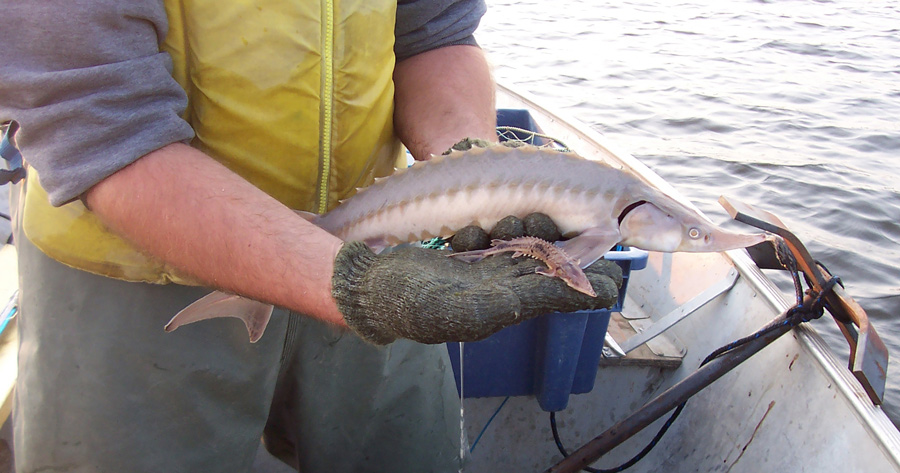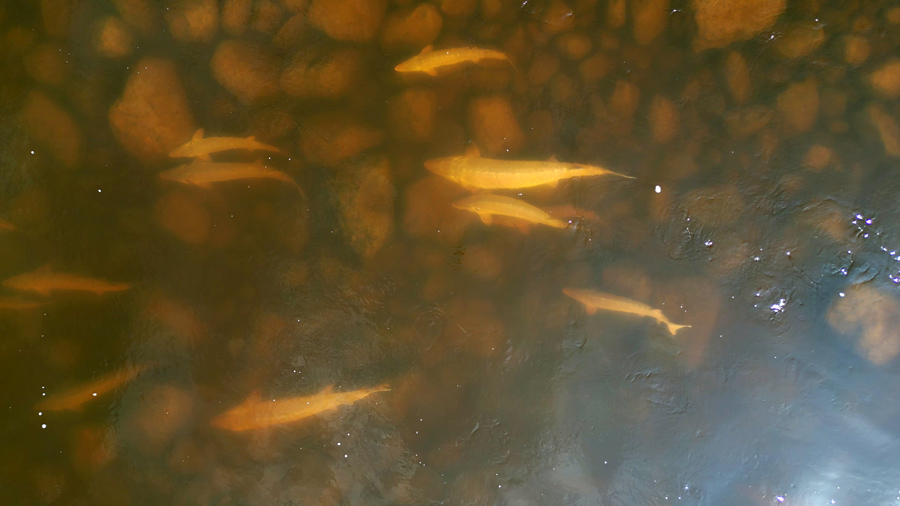What Lake Sturgeon genetics reveal about population structures
The freshwater fish Lake Sturgeon experienced drastic population declines across North America beginning approximately 150 years ago. Although commercial harvest has since ceased, many populations have been slow to recover. Stocking programs have been used to help recover the species, but they need to be approached cautiously as populations of fish that have been isolated for thousands of years may now be locally adapted to their habitats due to isolation by natural barriers such as waterfalls and large river rapids. Mixing fish from populations that are genetically distinct from each other can be problematic. Dr Patrick Nelson and Craig McDougall, of North/South Consultants Inc, Canada enlisted the services of Dr Louis Bernatchez (1960–2023) and Dr Thierry Gosselin to develop a genetic toolkit that can help determine the population structure of Lake Sturgeon, informing and guiding stocking programs.
Lake Sturgeon (Acipenser fulvescens) is a long-lived and late-maturing freshwater fish native to North America. In Northern Manitoba, Canada, the fish is resident in three river systems: the Nelson River, the Hayes River, and the Churchill River. Fewer Lake Sturgeon inhabit the region compared to 100 years ago, when commercial harvest of the species began in Northern Manitoba. In an effort to recover various Lake Sturgeon populations across North America, stocking programs are being implemented. However, there are concerns regarding mixing populations that are genetically distinct from each other.
Sound stocking strategies
Populations adapt to their specific habitat, so moving fish from one population to supplement the numbers of another can be problematic. Poorly informed genetic mixing of populations can lead to losses of local adaptation, with offspring of the broodstock lacking the genes adapted for the habitat into which they are being located to. Other negative effects include a loss of genetic diversity in populations, which may reduce fitness and survival of individuals, ultimately impacting the overall health of the population and increasing the risk of population crashes.

Dr Patrick Nelson and Craig McDougall of North/South Consultants Inc in Canada teamed with University of Laval researchers Dr Louis Bernatchez (1960–2023) and Dr Thierry Gosselin to better understand Lake Sturgeon genetics and population structure. The team developed a high-resolution genetic toolkit capable of identifying genetically differentiated populations of Lake Sturgeon living within Northern Manitoba riverine systems. Using their powerful toolkit, they revealed the existence of at least nine genetically distinct Lake Sturgeon populations. Their studies have important implications in relation to species recovery programs.
Lake Sturgeon in northern Manitoba
As the North American glaciers receded between 10,000 and 5,000 years ago, the rivers we see today in Northern Manitoba gradually took shape. Slowly, meltwaters drained into Hudson Bay and the levels of massive glacial lakes dropped. Numerous falls and rapids were formed where flowing water pitched over rocky outcrops. Hydroelectric dams have since been constructed at the sites of several of these falls and rapids. Genetic studies offer powerful insight into how long long-lived fish such as Lake Sturgeon were isolated even prior to the dams, existing as distinct populations for thousands of years.

Photo credit: Manitoba Hydro
In the late 1800s, Lake Sturgeon numbers began to decline as a result of commercial harvest. Since then, Lake Sturgeon hatchery programs have been implemented. For example, in the 1990s, the Nelson River Sturgeon Board (NRSB) began restocking efforts in the 653-km-long Nelson River. These efforts focused on the upper sections of the river, which previously supported a commercial Lake Sturgeon fishery. Broodstock was taken from the nearby Landing River, the closest known population that still maintained significant spawning. However, the optimal location for the collection of broodstock to support stocking initiatives in sections further downstream was uncertain. Large annual spawning aggregations observed in a lower Nelson River tributary were attractive; however, biologists were concerned that introducing Lake Sturgeon from distant locations along the Nelson River to another location could result in mixing of genetically distinct populations of fish, which could have negative impacts documented in other fish species.
Considering the genes
Nelson and his colleagues extracted DNA from over 400 tissue samples collected along the length of the Nelson River, as well as other rivers in Northern Manitoba, and then used genotype by sequencing (GBS) methods to identify thousands of genetic markers known as single-nucleotide polymorphisms (SNPs). After filtering using an established bioinformatic pipeline, a powerful genetic toolkit was created.
The genetic structure of Lake Sturgeon populations is influenced by historical isolation events, rather than more recent fragmentation.Genetic diversity (health) was generally similar (and high) among the groups of fish for which genotyping was performed, a basic but important finding that bodes well for species recovery potential. Extensive genetic differentiation (population structure) was observed among most groups of Lake Sturgeon sampled.

Photo credit: Manitoba Hydro
Two genetically distinct groups were identified in the upper Nelson River and another two in the middle Nelson River, while Lake Sturgeon captured from multiple sites within the lower Nelson River formed one group based on very similar ancestry. Fish sampled from the Churchill River revealed a further genetically distinct group. In the Hayes River, two more distinct groups were found. The research team have suggested that these groups should be considered as individual populations, based on the level of genetic differentiation that has occurred since they were isolated thousands of years ago. These findings have implications for both conversation stocking and broader fisheries management.
When did this differentiation occur?
Lake Sturgeon generation time is typically between 45 and 50 years. This means that if the observed differentiation occurred as the result of more recent barriers (hydroelectric dams), it would had to occur in just zero to three generations. Genetic modelling indicates that such rapid differentiation is highly unlikely. Nelson et al explain that the genetic structure of Lake Sturgeon populations in Northern Manitoba appears to be strongly influenced by historical isolation events, rather than the more recent fragmentation caused by development.
Understanding population structuring using genetics can help to inform effective stocking strategies for Lake Sturgeon.Nelson et al described how the genetic differentiation among Lake Sturgeon in Northern Manitoba observed by the researchers can be explained by multiple major glacial events that occurred between 10,000 and 5,000 years ago. As the amount of genetic differentiation between populations is influenced by the amount of time that has passed since isolation occurred, populations that have been isolated for longer should show greater differentiation.

Photo credit: Nelson River Sturgeon Board
Glacial recession would have resulted in a series of habitat isolations over time, progressing from upstream to downstream with the movement of glaciers and receding water levels, creating new barriers in the form of falls and rapids, changing the morphology of the area. This, in turn, would have prevented the movement of Lake Sturgeon between areas, creating the distinct populations observed today.
Insights for stocking strategies
Genetic analysis is a powerful tool for understanding population structuring and can help to inform effective stocking strategies for Lake Sturgeon. The research team emphasises the historical presence of falls or rapids in a riverine system as a good predictor of Lake Sturgeon population structure. Populations adapt over time to exploit the habitats they have access to and genetic mixing of previously isolated populations could have unintended negative consequences, such as loss of adaptation or reduced fitness.

Drawing upon the research team’s study, stocking of Lake Sturgeon in Northern Manitoba should be conducted logically, with broodstock capture taking place in the appropriate area for the site being stocked. For example, the upper Nelson River should be stocked using broodstock from the upper Nelson River. Similarly, it would be inappropriate to supplement upper Nelson River Lake Sturgeon populations using broodstock captured from the lower or middle Nelson River or the Hayes or Churchill Rivers. Stocking using offspring from the appropriate population avoids the potential negative impacts associated with mixing populations, supporting effective Lake Sturgeon conservation and fishery management strategies in Northern Manitoba riverine systems.
Personal Response
How would you like to see your research applied in practice?We hope that the information revealed in this study is applied in the context of species recovery initiatives. While the potential genetic impacts from stocking may be relatively innocuous for repatriation initiatives (or remnant extant populations), stocking may yield negative impacts for extant populations where wild spawning is occurring, especially if mate selection is not random or has a genetic component as our research suggests.